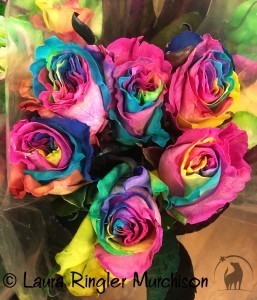The English playwright William Shakespeare once famously said, “What’s in a name? That which we call a rose by any other name would smell as sweet.” Sadly, his usually timeless words no longer always hold true. Growers have bred the smell out of roses in their attempts to create the longer-lasting Frankenrose. To me it is absolutely criminal. The colors are beautiful but the joy of flowers for me is in their delicate, fragrant scent emanating from their velvet petals. From the earliest times people from around the world have held the rose close to their heart. The first known roses to have flourished were around 35 million years ago. Hips have been found in Europe and petrified rose wreaths have been unearthed from ancient Egyptian tombs. The Romans surpassed the Greeks when Nero, the infamous unspeakably cruel and hedonistic emperor in the first century A.D., dumped dumped tons of rose petals on his dinner guests. Cleopartra had her living quarters filled with the petals of roses so that when Marc Antony met her he would long remember her for such opulence. We find references to roses in Christian literature as well as in ancient Confucian and Buddhist religious documents. In the Medieval Period the first known paintings of roses are on frescoes. The earliest example was discovered in Crete around 1600 B.C. The apothecary rose was first recorded in the 13th century near Provins, France. It was believed to cure a variety of illnesses and was turned into jellies, powders and oils. For me at least, I always associate the much maligned Marie-Antionette with the rose. The era of modern roses was established with the introduction of the first hybrid tea rose, “La France”, by the French breeder Guillot in 1867. My favorite color is dark blue, and I have planted “Blue Girl” roses in our yard which are actually lilac. It is my understanding that the blue color is the last of the roses to be hybridized. The symbolism of rose colors is steeped in tradition. Red can represent love, beauty, courage, and respect. White can represent innocence, purity, and reverence. Pink can mean appreciation and gratitude. Yellow can mean joy, gladness, and friendship. (The state flower of Texas is the yellow rose; the “Friendship State.”) Lavender can mean love at first sight, while orange can represent desire, fascination, or enthusiasm. I have read stories about the legends of the blue rose — they represent true love and prosperity. In some cultures blue roses are traditionally associated with “blue”, or royal, blood. Thus the blue rose can also denote regal majesty and splendor. Due to the absence of blue roses in nature they have come to symbolize mystery and the longing to attain the impossible. I am fascinated with cross-breeding as long as it is natural — no dyes (as pictured above), no GMOs; nothing artificial. My favorite color dark blue still has not been able to be naturally bred. And the longing for it gives me something to desire. Without the true roses’ sweet smell however the achievement will have fallen short. My Grandmother Maris used to wear Rose Milk and I have never forgotten her scent. I shall remain ever hopeful for my beloved rose to one day reveal herself: with a smell sweeter than any lily and a color richer than the darkest blue in sky or sea. Mystery and longing; something well worth the wait. And how sweet it will be.

